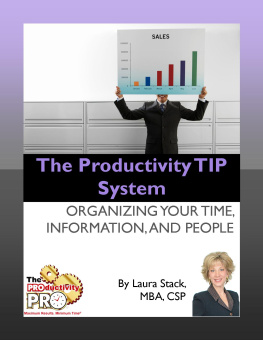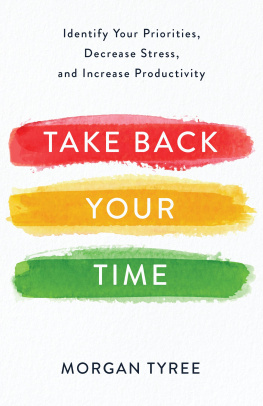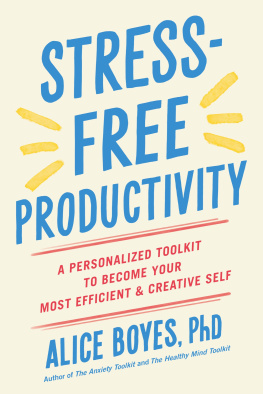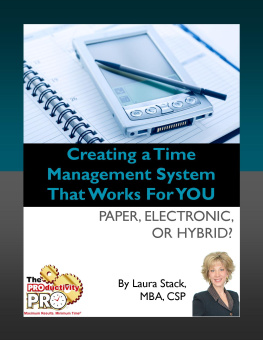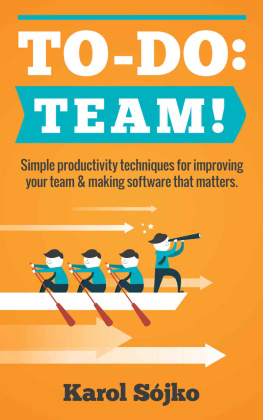Table of Contents
Take Control of Your Productivity (1.0)
Jeff Porten
Copyright 2018, Jeff Porten. All rights reserved.
ISBN for EPUB and Mobi version: 978-1-947282-23-0
Read Me First
Welcome to Take Control of Your Productivity, version 1.0, published in June 2018 by alt concepts inc. This book was written by Jeff Porten and edited by Joe Kissell with help from Caroline Rose. See .
This book provides you with the tools and information you need to create or improve your system for managing your goals and projects, both professional and personal, with concrete steps and strategies for implementing your tools and workflows, improving your results, and avoiding common pitfalls.
If you want to share this ebook with a friend, we ask that you do so as you would with a physical book: lend it for a quick look, but ask your friend to buy a copy for careful reading or reference. Discounted classroom and Mac user group copies are available.
Copyright 2018, Jeff Porten. All rights reserved.
Updates and More
You can access extras related to this ebook on the web (use the link in , near the end; its available only to purchasers). On the ebooks Take Control Extras page, you can:
Download any available new version of the ebook for free, or buy any subsequent edition at a discount.
Download various formats, including PDF, EPUB, and Mobipocket. (Learn about reading on mobile devices on our Device Advice page.)
Read the ebooks blog. You may find new tips or information, as well as a link to an author interview.
If you bought this ebook from the Take Control website, it has been added to your account, where you can download it in other formats and access any future updates. However, if you bought this ebook elsewhere, you can add it to your account manually; see .
Note: For the first edition of this book, most of the advance readers of this book were other Take Control authors, who are rumored to not be a random sample of the general public. Im especially interested in hearing back about what works for you, and whether anything is confusing. You can reach me at ; I cant promise individual replies.
Introduction
Most educational systems are designed with two objectives. The obvious one, which even young children grasp, is to teach students things they should know. The sneakier one: students are also learning how to learn, and methods theyll need for future self-education.
Oddly, little attention is paid to how to work. The usual advice is solely apply yourself and work harderand thats parallel with increasing responsibilities and more dire consequences from falling short.
Eventually, work harder stops working. If thats the only tool in your toolbox, no wonder youre having difficulty. Your body and mind have limits, but demands on you do not. You need better methods.
Everyone has a first time picking up a book like this one, and its almost always a response to frustration about their DIY methods. It doesnt matter what you dostudent, career professional, self-employed, retiredif you do things, you can become dissatisfied with how you organize yourself or your results. There are three rough categories that describe that feeling of dissatisfaction:
Youre exasperated with what youre doing, or with the outcome of what youre doing. Either its quantitatively lower output than youd like or its qualitatively divergent from your larger goals (which you may have never articulated).
You can feel external pressures and the metaphorical heat increasing, and you have to proactively increase your skills to match.
Youre already in crisis, and you know you should do something differently, but you dont yet know what.
In this book, youll learn strategies for all three. The process of improving your productivity and skills is ongoing, but crisis management is somewhat different, with an approach you can use as needed.
Im an expert because this is the book I desperately needed to read a long while back. Ive read nearly all the other popular ones over the years. Most had good ideas (and those that didnt were highly entertaining, in ways the author clearly didnt intend). They fell into two groups: interesting theories that fell short of telling me what to do at 2 p.m. every Tuesday, or books with specifics that worked well so long as I was the same kind of person as the author.
Im not going to do that to you. Im highly idiosyncratic, and so are you. Youre not going to do exactly what I do when you finish this book, which contains very few point here, click there instructions. Instead, youll learn detailed steps for building something similar to the examples I discuss, but with plenty of latitude to fit your own needs. You and I are going to end up with similar houses, but yours will be a different color, with your own furnishings, and maybe a porch.
I spent 20 years discovering how to build my house, and learning the reasons behind what works and what doesnt, before I invented a system that worked well and worked reliably. Your process will be measured in weeks or months, because youll skip most of the trial and error, and learn from my mistakes. (In some cases Ill tell you what they were, but most of the time Im omitting horrible and time-consuming advice.)
Im different in another way: Im diagnosed with bipolar II and attention deficit disorders. My productivity system acts as an outboard brain, to help me through the times when my own brain is dysfunctional. When Im depressed or irrationally manic, my work capacity radically changes. Meanwhile, my ADD means I am literally unable to pay attention the way most people can.
What this means for you is that it doesnt matter who you are, or what youre dealing with. Youre not the exception who cant use these techniques. The more uncomfortable they feel, the more theyll help. If they can work for me, they can work for anyone. You just have to determine how they should fit to you, instead of the other way around.
Quick Start
This book is designed to be read repeatedly, but I recommend you read it linearly the first time. Skipping parts may confuse you, or cause you to miss important steps. When you read it againthe book recommends when you should!do so in any order you wish.
Everything you need is in these pages, but there is also additional information that was either useful but secondary to the main points or only applicable to some readers. Ive moved that information to the web. At times youll see this, to let you know whats there:
Web content: These asides point you to specific related posts on the books blog. There is also an index post that includes every link to the blog in this book, and informs you of anything that might be added or updated after publication.
Heres what youll find in this book:
Learn Key Concepts
, youll be examining yourself so that what you build is perfectly tailored to your own unique requirements.
Dont skip , or youll find later chapters to be rather confusing. The book redefines some common words and creates a few new terms.
Get Up and Running
You need to based on your own requirements and preferences. You may need some new apps, and maybe a few new gizmos and nontechnical tools as well. You may also change how you use your existing tools.
Then its time to : set up your tools and add your first projects (including one I provide that helps you manage your new system).


